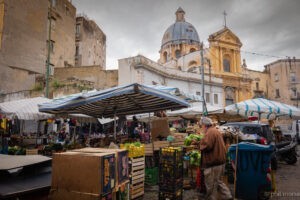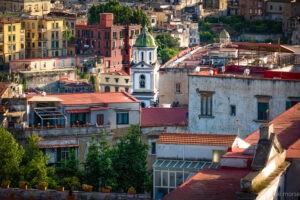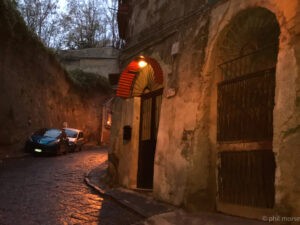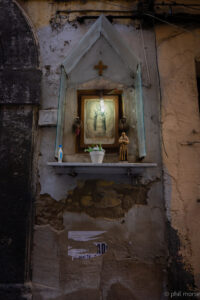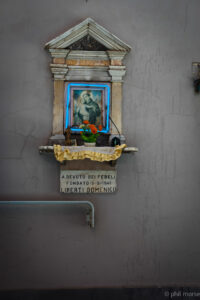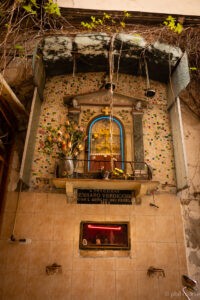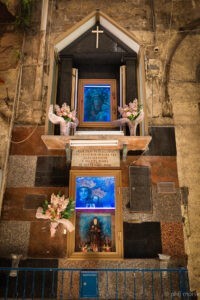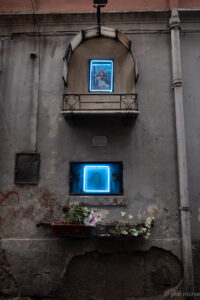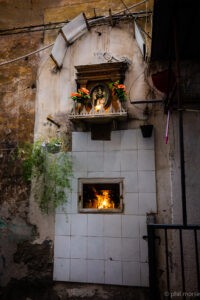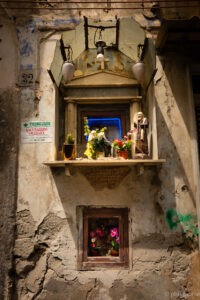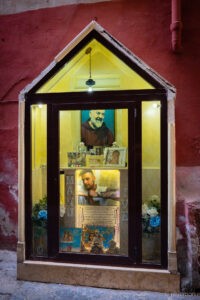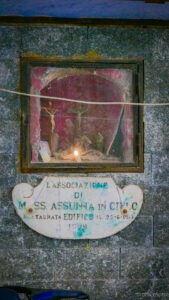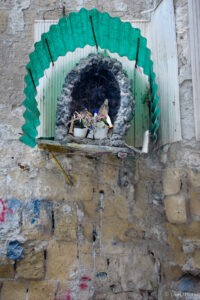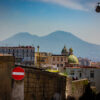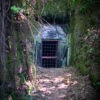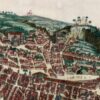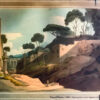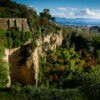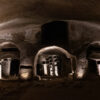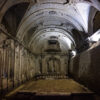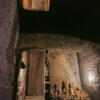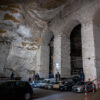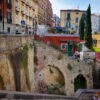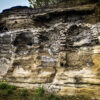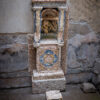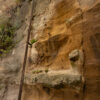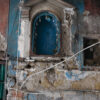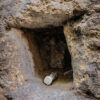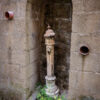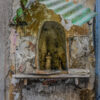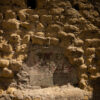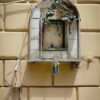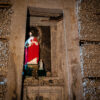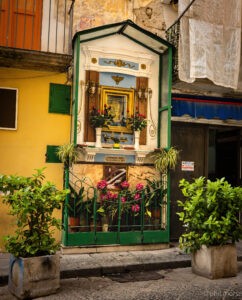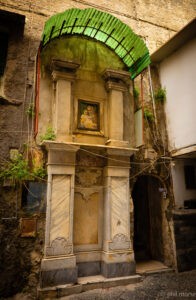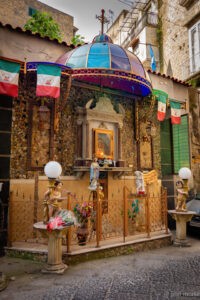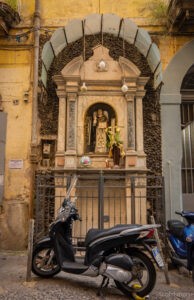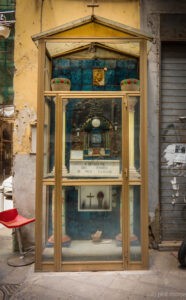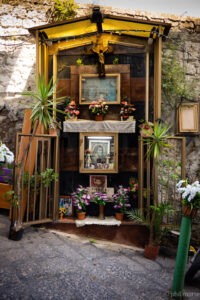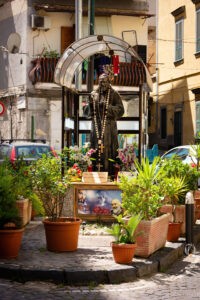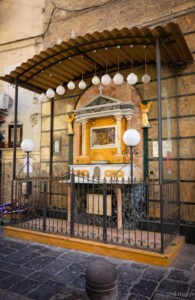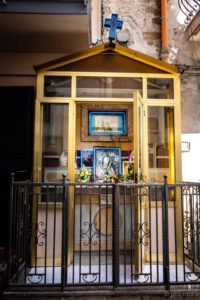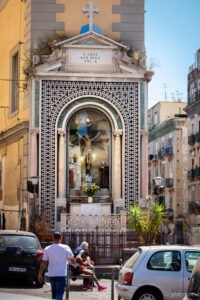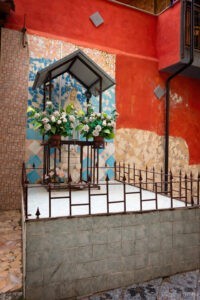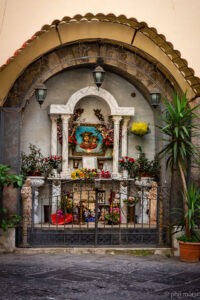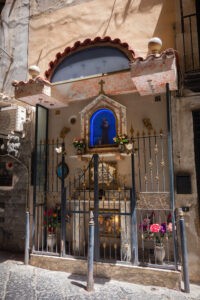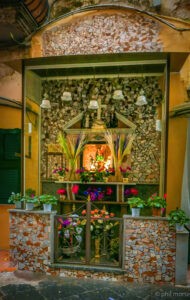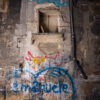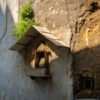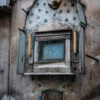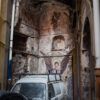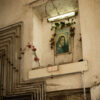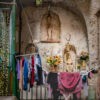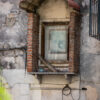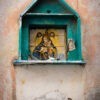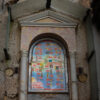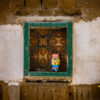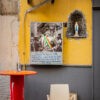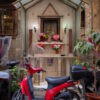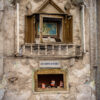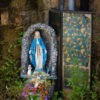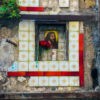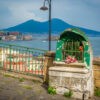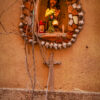Edicole Votive
Edicole literally translates as newsstand or kiosk. Edicole votive, then are religious stands…shrines.
I culled this collection of photos of votive shrines that I found in Naples from about 400 images. What I attempt to do here is provide some context, a little history, and a little speculation about the ways they resonate with the culture and the topography of the region. Three themes emerge that strike me as important: The significance of the underground in Neapolitan life and the way it informs structure and spirit; The concept of the niche as a special place for worship; The way craft and artistry affect expression.
Most of the images here are from the Sanita, a large quarter of the city that lies between the historical center and the hill known as Capodimonte, site of the royal palace. But many also come from other parts of the city. The votives find their origin in the time of Carlos V, when the city was dark and dangerous. At Carlos’ behest, a Dominican, Padre Gregorio Rocco, enjoined the faithful to illuminate the streets with lighted votives to the saints. People had reason to be observant. The plague had caused half the population to be interred in the cemetery of the Fontanelle. The illuminated votives comprise many forms. Reflecting their origins, they commonly echo the classical architecture of the 17th century. Often they include grottoes or niches as forms of enclosure, and cavern like chambers that have a particular relationship to the region. Where candles were originally used, now there are all forms of electric light, including LED’s and fluorescent tubes. Execution ranges from crude, hand-made objects to hi tech anodized aluminum and glass structures.
I did all the post processing of these photos in Adobe Lightroom and Topaz Labs AI, where needed. Many of the images deserve better but they are what I had. Because the images are so rich in detail, I have used larger file sizes than normal and included zoom functions for all. Hopefully, the time they take to load will be offset by the interest of the details. I see this site as the beginning of a project that others could add to, make corrections, and take in other directions; and the end of my contributions, for now.
Below, an introduction to the range of what I found. Most here are illuminated, as that was their original purpose…
Underground
Naples sits on a honeycomb of voids. They are more than just a network of chambers and galleries – They are a presence that forms a connection with the past and a spirit that informs the here and now; and a source of legendary figures who laid claim to the city’s collective unconscious. The shadowy character of Pulcinella, cistern dweller, transmitter of assignations, is ubiquitous. He embodies the suffering, sensual, tragicomic nature of Neapolitan aspiration. The yearning to be free. The failure. There is also the little monk, O Monicello, another shape shifting trickster who makes his dwelling in the dark recesses of the underground.
The Greeks were among the first to quarry the soft yellow volcanic stone called Tufa that underlies all the local topography. They built a necropolis that went two stories below grade, east of their city at the foot of the cliffs of a ravine gutted hill now called Capodimonte. Those burial chambers got buried in centuries of mud that washed down from above. In Roman times many were re-purposed as cisterns for water brought into the city by aqueduct. The use of stone for building left the area further pitted with quarries, many of which underlie buildings that went up in the 17th century. As the slopes of Capodimonte were developed, ravines were turned into roadways with retaining walls to hold the soil in place, all of which required more quarried Tufa. Anywhere you go in Naples you see Tufa; behind peeling stucco, on top of ancient Roman brickwork, in walls that hold back the earth. And it all came from somewhere below.
The voids, the negative spaces of the city are felt everywhere. Entrances to caves pock the hillsides of Capodimonte, sit behind facades and in quarries. Tunnels open to an internal labyrinth of caverns and passageways. Even niches built into retaining walls suggest an interior presence. They amplify the spiritual, which is interior by nature. Naples has always been pagan. It has always had soul. That these shrines continued to develop as a form of Neapolitan expression is a natural consequence.
The Niche
All that remains of the original Greek settlement on Mount Echia, known today as Pizzofalcone, are four disheveled niches that face the sea. At one time, perhaps, A marble figure of Partenope looked out from there, waiting for her Ulysses. I find them especially moving by their emptiness.
The niche is a special place of concentration. Its form echoes the human thorax, residence of the heart, engine of all feelings, great and small. Many of the votives are simply niches, nothing more. Or, they incorporate niches in their overall scheme. In concept, they are all niches, that is, a special place for a moment of concentration.
In Naples, it seems there is a niche for everyone and everything. A hole in a wall, a closed off tunnel will do, if you happen to find one. They come large and small. The honorific “O” can apply to anything you could place there, even death itself. Honor is due to all things when their time comes.
Street Chapels
Things have a way of getting complicated. You start by making omelets. You move on to souffles. The street chapels are the haut cuisine of Neapolitan votive shrines. They can also be repositories of values that are less than spiritual, like power and prestige. While some are elaborate family memorials, others seem imperious. An art form that is universal in its adaptation of architectural styles, religious content, and personal sentiment, has evolved to include the complex coexistence of the real powers that be. Some of these large street chapels are elaborate fronts to give religious standing to local gangs. The Camorra and the Church coexist in Naples by mutual consent. If you have a power in Naples, this is one way to show it. For me, they represent an extraordinary use of craft in the service of devotion, real or imagined.
Favorites
These are the votives that I find particularly interesting, either because of some formal quality, or because they resonate with my own interest in making things. Some, I find simply moving. Some are little discoveries that shine a light on the quirky, exuberant, and amusing spirit of Neapolitan life.
Purgatory
The little chambers that one often sees below the main shrine are no afterthought. A land so often thought of as a paradise but that is home to so much suffering, demands acknowledgement of the thing that must be named: Purgatory.
Although Purgatory was never officially recognized by the Church, it has survived in the popular imagination and must have been essential to the Catholic mindset that prevailed at the time of Carlos V. In essence, it’s a place where souls not damned go to be purified in order to get into Heaven; and to benefit from the prayers and offerings of the living. While some of the votives are, in fact, collection boxes, these niches appear mostly to be spaces for the personal in the form of family photos. If they represent the factual place of Purgatory, it is here that one remembers the dead and offers prayers to speed them on to heaven.
Maybe in their earliest iterations these little rooms were more Catholic in their references to death and cleansing fires: penitents, skulls (ever so popular in Napoli) and crucifixes. Now, while you still find little naked figures with arms outstretched, bathing in flames, you can just as easily find symbols of hope and succor along with the family photos: portraits of Jesus and Mary, Padre Pio in various forms, bottles of holy water, flowers of all kinds, and electric candles.
While popular culture associated Purgatory with fire, the Church never did. But it’s not surprising that in a land that sits on a cauldron of molten lava the idea of fire dominates these spaces. And what better place? The little boxes reproduce for me, the real world of ever-present danger and misery that underlies the ideal, where the Neapolitan speaks from experience and the gut. I have seen lots of shrines in other places. This form of expression seems particular to Napoli, spread about the foot of Vesuvius, God of fire.
Acknowlegements
I found two sites very helpful in forming my thoughts about this page. They make for fascinating reading.
Carlo Leggieri on the Hellenistic underpinnings of the Sanita.
Jeff Matthews on underground Naples and more
